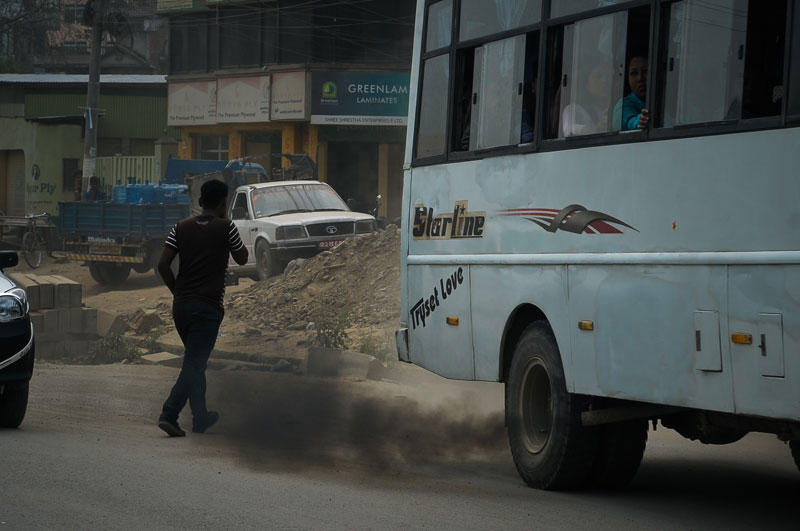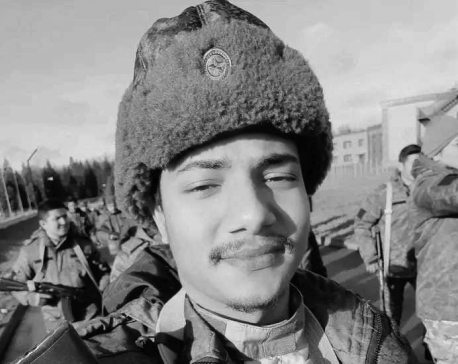
OR

You won’t be able to walk for 15 minutes in Kathmandu today without feeling suffocated by smoke and dust
Nepal is known for its natural beauty. Until the early 70s, people in Kathmandu lived with pristine water in Bagmati River, clean and blue sky without a blip of smog and the ever-flowing water sprouts. The environment had no streak of pollution mainly because of low population density, few vehicles, manageable infrastructure, and negligible effect of global warming.
Today, you won’t be able to walk for 15 minutes without feeling suffocated by smoke and dust, so much so that people have started calling Kathmandu ‘Dustmandu’. Global warming has added to our woes. According to the Environmental Performance Index 2016, Nepal ranks 177th in air quality out of 178 countries surveyed, and Kathmandu is now the seventh most polluted city in the world.
Indeed, the global warming effects are spiraling since it was first noticed in 1975. The Arctic Sea is melting rapidly, causing sea levels to rise and threatening the existence of small island nations in the Pacific and Indian Oceans. We are also witnessing an alarming level of melting of polar ice, fast losing our coral reefs and witnessing an inexorable rise of ocean levels. In the past 30 years alone, the world has lost 50 percent of its corals; only 10 percent of it is expected to survive beyond 2050.
Burning of oil, coal and natural gas as well as deforestation have increased the amount of carbon dioxide in the biosphere. According to the UN Refugee Agency (UNHCR), approximately 22.5 million people were displaced by climate- or weather-related disasters between 2008 and 2015.
In the Paris climate conference in 2015, the whole world pledged to do all they could to cap the rise in global temperature at 1.5 degree Celsius above the level witnessed at the start of the Industrial Revolution. But we are unlikely to achieve this target. Statistically, the world emits approximately 40 gigatons of carbon dioxide a year. We need to halve it, to 20 gigatons, to achieve the 1.5 degree Celsius target.
Unplanned and chaotic construction, coupled with haphazard road repairs have greatly contributed to air pollution in Kathmandu. The repeated digging and repairing of roads, a clear result of lack of coordination between various government agencies, the snail-paced road construction, and addition of thousands of vehicles every month have further aggravated the situation. As a result, thick layer of dust blankets the city.
According to a 2016 World Health Organization study, air pollution causes three million deaths a year worldwide. The Global Burden Disease Study (GBD) shows that Nepal recorded almost 32,000 premature deaths in 2015 because of outdoor pollution, mostly from coronary artery diseases and strokes. People are also suffering from bronchitis, allergic asthma and chronic obstructive pulmonary diseases. Although air pollution directly increases cardio-respiratory complications, GBD also suggests its adverse impact on the health of children and the elderly.
Air pollution has deprived people of their right to healthy life. Article 30 of the constitution grants every Nepali citizen the right to live “in an environment free from health hazards.” Kathmandu’s dust and smog keep us from enjoying this constitutional right.
Pollution problem, however, is not specific to Nepal. But other countries have taken steps to control pollution. According to a Greenpeace India report in 2017, around 1.2 million Indians succumb to various kinds of pollution every year. This is why the country is now speeding up road construction, reducing traffic by increasing fuel taxes, levying congestion charges and promoting vehicle-free zones in polluted areas.
Likewise, China has a Five-Year Plan on green development, focusing on reduction of emission from coal-burning industries, boosting efficient use of fossil fuels, encouraging renewable power and reusing waste material. Similarly, the Netherlands now has a green energy law which aims to remove from its cities petrol/diesel cars by 2025.
What have we done?
Nepal, in line with the UN Sustainable Development Goals, aims to take effective measures to substantially cut down on the number of pollution-related deaths by 2030.
The government has drafted legislation on ambient air quality monitoring, pollution tax on fuel and ban of polluting vehicles. But these policies have not been followed up. Activities contributing to air pollution have drastically increased over the years but the government has failed to do anything about it. If this dismal trend continues, we might suffer something similar to ‘The Great Smog’ of London—where a week-long smog in 1952 killed as many as 4,000 people and directly affected lives of 100,000 residents—or worse.
Thus we need urgent plans to mitigate air pollution and global warming effects. To begin, road construction can be expedited. There should also be better coordination among agencies working on road construction, laying down of water pipe, sewerage, telephone and cable networks so as to prevent the digging up of roads repeatedly.
Likewise, we should limit vehicle import. We can also implement the odd-even number system to prevent congestion and to reduce pollution. These are short-term measures. For the long run, we need to build cycle lanes and promote cycling as a viable means of transport, apart from switching to electronic vehicles; as load-shedding is slowly becoming history, this is very possible.
According to recent data, in the most polluted regions of the world, nearly double the number of people are dying from air pollution as they are dying from tobacco use. This is not something we can continue to ignore.
The author is an alumni of Henan University of Technology (HAUT), China
You May Like This

Another Nepali youth dies in Russia-Ukraine war
PYUTHAN, Jan 11: A youth from Pyuthan district, who was serving the Russian Army, died in the Russia-Ukraine war. ... Read More...

Tragic accident claims young life during cannoning
KATHMANDU, July 27: A 22-year-old girl, Anjita Bhandari, from Pokhara Metropolitan City-26 Budhi Bazar, lost her life after a mishap... Read More...

Monsoon death toll in three days reaches 83
KATHMANDU, JULY 27: With an additional 36 deaths confirmed on Wednesday, the death toll from landslides and flooding across the... Read More...




Just In
- Govt receives 1,658 proposals for startup loans; Minimum of 50 points required for eligibility
- Unified Socialist leader Sodari appointed Sudurpaschim CM
- One Nepali dies in UAE flood
- Madhesh Province CM Yadav expands cabinet
- 12-hour OPD service at Damauli Hospital from Thursday
- Lawmaker Dr Sharma provides Rs 2 million to children's hospital
- BFIs' lending to private sector increases by only 4.3 percent to Rs 5.087 trillion in first eight months of current FY
- NEPSE nosedives 19.56 points; daily turnover falls to Rs 2.09 billion
















Leave A Comment